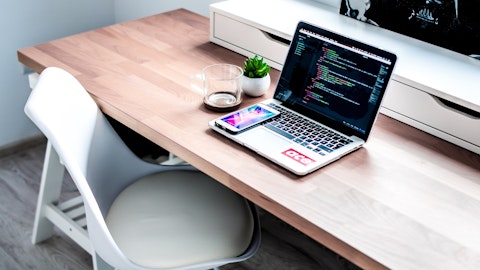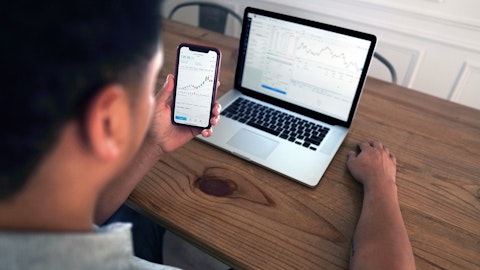Anu Muralidharan : All right. So I hope that is as exciting to you as it is to us. Because the entire point is to engage the end user as soon as they come into the product and to give them so many different use cases that enhance their experience, enhance their lives, make their most painful tasks easier such that we activate them sooner rather than later. So on this slide, I want to go into this end user flow in a little bit more detail. And this specific flow is actually going to launch, maybe as soon as next week. So imagine an employee that isn’t trying to adopt Expensify for their company, is just trying to make their process of maintaining these receipts, submitting to their employer a little bit easier. So they come into Expensify, that screen on the far left is where they would land when they sign up.
So on that screen, they can create a new chat, find their manager, and within the chat interface with their managers — so, now we’re the third markup — they can click that green button at the bottom, and that takes them to the screen, the fourth screen from the left and request money. Now, they can request money by manually entering the amount or they can scan a receipt or it can be a distance related expense, whatever, the options — all of the same options that existed or exists on our current product will exist here. So for the sake of this, let’s just — let’s take this example, let’s go with the manual version. So the $20 for gas, click send, and now their manager asks this money request from them. How does the manager receive this? So assuming the manager is not an existing customer, which if they are, then they will receive it in both e-mail and in app notification.
But for the sake of this example, let’s assume they’re not. They see this e-mail. So it’s really clear [Alice] is requesting $20. Like the call to action is really clear. They come in, the e-mail is designed in a manner that kind of invites them to click on it. So when they click on it, they can sign up into the app and pay this employee immediately. So manager clicks on it, they are dropped into the in-app experience, into the direct message with [Alice] and the hit pay. Now, it’s possible that some VSBs are not looking to adopt an expense product for the entire company just yet, all they want to do is pay this employee and that’s the end of it. They maybe don’t have a business bank account yet. So if that’s the case, they can choose to just pay with their personal bank account or debit card, and it would feel like any other P2P transaction.
But if we choose to pay with the business bank account, then we know that their business that is at a stage that might be ready to adopt the product. So first, we’ll take them to connect their business bank account, of course, and complete the action they came here to complete. But after that, we will take that expense. We will create a workspace for this manager, and we add the employee and the manager to that workspace, and we put the expense into that workspace as well. So in this screen, you can see, we’ve kind of created the workspace. We’ve put the manager and the employee in there, and then we’ve moved the expense over and we leave breadcrumbs on the direct track between 2 of them to let them know what we’ve done. So right here, behind the scenes, in a very intuitive and smooth fashion, we’ve upgraded their experience to be a business use case and then concierge and the assigned onboarding specialists we continue that conversation with them to see how they can onboard the rest of the company, what their needs are.
Does this fit where they are today, because this is not an irreversible action. It just encourages them down a path that we think is best practice. So that’s the product. And like I said, we’ve been talking about it for a long time. The entire point of building it is, I want to put in perspective to engage this vast amount of inbound momentum we already have from end users and very small businesses, and we need to find a way to activate their experience sooner rather than later, and we are optimizing the new product to do exactly that. And we believe that, of course, the first iteration of anything is going to have a lot of opportunities for growth. But we believe that as we continue iterating, tweaking and refining that workflow, we are going to activate the bottom of the market in a much more effective manner than anybody else can.
And this isn’t about competitors really, like sure, we can do better than competitors. But this is about unseeding inertia. This is about taking the greenfield opportunity, and that’s still where our sites are firmly set. I want to do a brief Q3 business update and then I’ll hand over to Ryan. So this quarter, we’ve remained pretty focused on SEO and paid digital advertising. And the reason we put that at the very top of this slide is because, as I said, we have all this inbound momentum. We’re trying to capitalize the inbound momentum on Expensify 2.0. But we could always use more inbound momentum. But as we go to the bottom of the market, it is not for the taking using a sales driven strategy. And so the more dialed in our organic efforts are, and the more we can bring down that cost per click on our digital efforts, the better we can capitalize on that bottom of the market and do some momentum.


